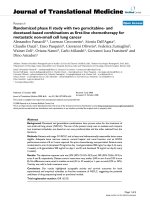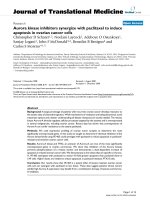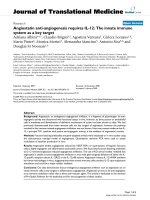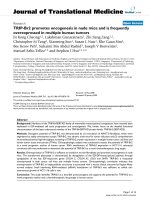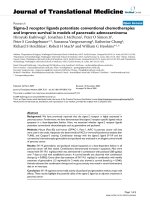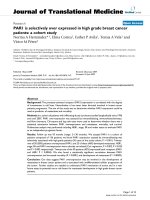Báo cáo hóa học: " Bi-Functional Silica Nanoparticles Doped with Iron Oxide and CdTe Prepared by a Facile Method" doc
Bạn đang xem bản rút gọn của tài liệu. Xem và tải ngay bản đầy đủ của tài liệu tại đây (320.69 KB, 6 trang )
NANO EXPRESS
Bi-Functional Silica Nanoparticles Doped with Iron Oxide
and CdTe Prepared by a Facile Method
Cuiling Ren Æ Jiefang Sun Æ Jinhua Li Æ Xingguo Chen Æ
Zhide Hu Æ Desheng Xue
Received: 15 December 2008 / Accepted: 5 March 2009 / Published online: 20 March 2009
Ó to the authors 2009
Abstract Cadmium telluride (CdTe) and iron oxide
nanoparticles doped silica nanospheres were prepared by a
multistep method. Iron oxide nanoparticles were first
coated with silica and then modified with amino group.
Thereafter, CdTe nanoparticles were assembled on the
particle surfaces by their strong interaction with amino
group. Finally, an outer silica shell was deposited. The final
products were characterized by X-ray powder diffraction,
transmission electron microscopy, vibration sample mag-
netometer, photoluminescence spectra, Fourier transform
infrared spectra (FT-IR), and fluorescent microscopy. The
characterization results showed that the final nanomaterial
possessed a saturation magnetization of about 5.8 emu g
-1
and an emission peak at 588 nm when the excitation
wavelength fixed at 380 nm.
Keywords Iron oxide nanoparticles Á CdTe Á
Fluorescent Á Magnetic Á Preparation
Introduction
Magnetic nanoparticles offer great potential in biomedical
applications, including magnetic resonance imaging (MRI),
targeted drug delivery, rapid biological separation, bio-
sensors, and magnetic hyperthermia therapy. Among the
magnetic nanomateials, iron oxide nanoparticles (including
Fe
3
O
4
and c-Fe
2
O
3
) are by far the most commonly
employed material because of their biocompatibility [1–4].
At the same time, cadmium telluride (CdTe) nanoparticles,
as an important II–VI semiconductor material, have
attracted considerable attention over the past decades. They
have some unique physical and chemical properties, such
as marvelous brightness, narrow and size-tunable emission,
fairly high quantum yields, and good chemical and photo
stability. These properties make CdTe nanocrystals suitable
for biological applications, fabricating photoelectron
devices and solar cells [5–11].
So the multifunctional nanomaterials which were com-
posed of iron oxide nanoparticles and CdTe nanocrystals
can enjoy both the advantages of iron oxide nanoparticles
and CdTe QDs (quantum dots), they showed great potential
in biological applications [12–14]. These multifunctional
silica spheres are expected to serve as luminescent markers
and are capable of being driven by an external magnetic
field to a specific location [15]. For example, in a targeting
drug-delivery system, the magnetic fluorescent nanoparti-
cles labeled drugs could be easily administered and
transported to the terminal under the guidance of an external
magnetic field, resulting in a safer and more effective tissue-
specific delivery of drugs.
Until now, various approaches have been employed to
prepare the multifunctional nanoparticles composed of iron
oxide nanoparticle and CdTe quantum dots (QDs). To the
best of our knowledge, the major approach was layer-by-
layer techniques [16–18]. And some other methods were
also developed [19]. Although these approaches are very
successful in preparing fluorescent magnetic nano- or
micro-sized spheres, they are rather laborious and time-
consuming or need more organic solvent. Better preparing
techniques are still needed to develop. The previous study
C. Ren Á J. Sun Á J. Li Á X. Chen (&) Á Z. Hu
Department of Chemistry, Lanzhou University,
Lanzhou 730000, People’s Republic of China
e-mail: ;
D. Xue
Key Laboratory for Magnetism and Magnetic Materials
of MOE, Lanzhou University, Lanzhou 730000,
People’s Republic of China
123
Nanoscale Res Lett (2009) 4:640–645
DOI 10.1007/s11671-009-9295-9
indicated QDs can be assembled on the silica surface by
amino group, and Liu et al. [20] have modified the surface
of silica coated iron oxide nanoparticles with CdSe by this
principle. But until now, no one has combined iron oxide
nanoparticles and CdTe by amino group. In this study, we
prepare bi-functional silica nanospheres doped with iron
oxide nanoparticles and CdTe QDs by this protocol for the
first time. The preparation procedure was shown in
Scheme 1, iron oxide nanoparticles were first coated with
silica and then it was modified with amino group. After the
CdTe nanocrystals assembled on the particle surfaces, a
final silica shell was deposited. Herein, the synthesis and
detailed structural, magnetic, and optical property of this
multifunctional nanomaterial were presented.
Experimental Section
Chemical Reagents
Tellurium powder was purchased from Shanghai Chemical
Reagents Factory, China. NaBH
4
was commercially avail-
able from Guangming Reagent Company, China. Ferric
chloride (FeCl
3
Á 6H
2
O) and Ferrous chloride (FeCl
2
Á
4H
2
O) were purchased from Tianjin Shuangchuan Chemical
Reagent Factory, China. TEOS was purchased from Tianjin
Chemical Reagent Company, China. 3-aminopropyltrime-
thoxysilane (APTMS) was commercially available from
Fluka. Other routine chemicals were purchased from
Shanghai Reagents Factory of China. Doubly deionized
water was used throughout the experiment. All chemical
reagents were of analytical grade and used as received
without further purification.
Preparation Procedure
Thioglycolic acid stabilized CdTe nanocrystals were pre-
pared according to a reported procedure with some
modification [21]. Typically, 6 mL of 0.02 M CdCl
2
and
100 mL of water was mixed together, and then the pH of
the mixture was adjusted to 11.3 in the presence of 26 lL
of thioglycolic acid. After stirring and bubbling with
nitrogen for 40 min, NaHSe prepared by 6.0 mg Te and
6.0 mg NaBH
4
was added. After 1 h stirring, it was
refluxed for 3 h.
Silica coated iron oxide nanoparticles were prepared as
described by our previous work with some modification
[22]. First, iron oxide nanoparticles were prepared from
aqueous solution of Fe
2?
/Fe
3?
by the addition of ammonia
under magnetic stirring at room temperature. Then it was
coated with silica. Typically, 2.5 mL of magnetic nano-
particles solution, 2.5 mL of distilled water, 30 mL of
isopropyl alcohol, and 80 lL of TEOS were put together.
The reaction was initiated by 0.8 mL of ammonia
(25 wt%). After magnetic stirring for 10 h, the formed
core–shell nanoparticles were collected by centrifugation
and the silica coated iron oxide nanoparticles were denoted
as FS nanoparticles.
The surfaces of FS nanoparticles were modified with
amino group by treating with APTMS in refluxing toluene
[23]. Typically, 260 mg of FS nanoparticles was added to
200 mL of toluene, and then refluxed for 6 h after 2.0 mL
of APTMS was added.
In order to prepare CdTe assembled FS nanoparticles,
5.0 mg of the prepared CdTe and amino group modified FS
nanoparticles were dissolved in 2 mL of water, respec-
tively. Then the two dispersions were mixed together and
stirred for 12 h. The final product was isolated by centri-
fugation and it was denoted as FSC nanoparticles.
The prepared FSC nanoparticles were further coated
with an outer silica layer. After being dispersed in 1 mL of
H
2
O and 4 mL of ethanol, 4 lL of APTMS and 10 lLof
TEOS were added to the FSC dispersion under magnetic
stirring, the procedure was preceded for 10 h [23]. Finally,
the product (denoted as FSCS nanoparticles) was centri-
fuged and dispersed in water for further characterization.
Characterization
Photoluminescence (PL) spectra were made with a RF-
5301 PC spectrofluorophotometer at room temperature.
Fluorescence microscope was used to show the optical
images of the product. X-ray diffraction (XRD) pattern of
the product was performed on an X’Pertpro Philips X-ray
diffractometer with CuK
a
radiation (k = 0.154056). The
scan range (2h) was from 10° to 90°. Transmission electron
microscopy (TEM) images were used to show the
Scheme 1 Preparation procedure of multifunctional nanoparticles
composed of iron oxide nanoparticles and CdTe nanocrystals
Nanoscale Res Lett (2009) 4:640–645 641
123
morphology and size of the as-prepared samples. Nicolet
AVATAR 360 Fourier transform infrared spectra (FT-IR)
spectrometer was used to demonstrate the chemical nature
of the products in KBr pellets. Magnetic hysteresis loops of
these core–shell nanoparticles were carried out with a
vibration sample magnetometer (VSM, Lakeshore 730,
America) at room temperature.
Results and Discussions
Figure 1a showed the XRD spectra of the FS nanoparticles.
The peaks in the range between 10° and 90° demonstrated
the iron oxide nanocrystals were Fe
3
O
4
and/or c-Fe
2
O
3
[24]. But it was not essential to distinguish them because
they had similar magnetic property. The average particle
size of the iron oxide nanoparticles was calculated to be
about 10 nm by the \311[ XRD peak [25]. Besides the
peaks of iron oxide, there was a broad featureless XRD
peak at low diffraction angle, which was corresponded to
amorphous SiO
2
shell.
The XRD spectrum of CdTe nanoparticles was depicted
in Fig. 1b. The diffraction peaks were similar with the
previous reports [26, 27]. It indicated the nanoparticles
belonged to cubic structure. The average particle size of
CdTe nanocrystallite was estimated to be about 3 nm by
Scherrer formula.
Figure 1c showed the XRD pattern of FSCS nanoparti-
cles. According to Fig. 1a, the diffraction peaks of iron
oxide and silica were present in Fig. 1c. But the existence
of CdTe in the particles could not be confirmed by the
XRD spectrum because the peaks were ambiguous.
In order to investigate the morphology and size of the
prepared nanoparticles in every step, TEM measurement
was carried out (Fig. 2). As shown in Fig. 2a, CdTe
nanoparticles were nearly monodisperse with an average
particle size about 4 nm, which was a little bigger than the
result obtained by XRD analysis. Figure 2b showed the
TEM microphotographs of amino group modified FS
nanoparticles. As observed, the black dots with a diameter
of about 10 nm in the particles were iron oxide nanopar-
ticles, which were surrounded by silica. The average
diameter of the particles was 40 nm. Their size distribution
was narrow, though aggregation appeared in some area.
Amino group could not be observed by TEM. The TEM
image of the CdTe nanocrystals assembled FS nanoparti-
cles was shown in Fig. 2c. It can be seen that there were
some dots on the amino group modified FS nanoparticles
surface, which was corresponded to QDs. According to the
previous study, the strong binding interaction between
the amino groups and the QDs was the driven force for the
modification of CdTe nanocrystals on the surface of FS
nanoparticles [23, 28, 29]. Finally, the FSC nanoparticles
were coated with an outer silica layer. As shown in Fig. 2d,
the diameter of the FSCS particles was about 55 nm. But
the particles were aggregated caused by the interactions
between the magnetic nanoparticles. So the TEM results
proved the existence of CdTe nanocrystal in the final
multifunctional particles.
The optical property of the prepared nanoparticles was
investigated by PL spectra. Line a in Fig. 3 indicated the
final multifunctional nanoparticles exhibited an emission
Fig. 1 XRD patterns of a FS; b CdTe; c FSCS nanoparticles
642 Nanoscale Res Lett (2009) 4:640–645
123
Fig. 2 TEM images of a CdTe;
b amino modified silica coated
iron oxide; c FS nanoparticles
further assembled with CdTe
QDs; d the final multifunctional
samples
Fig. 3 PL spectra of a FSCS; b CdTe nanoparticles
Fig. 4 Magnetic hysteresis loop of the final bi-functional material
measured at room temperature
Nanoscale Res Lett (2009) 4:640–645 643
123
peak at 588 nm when the excitation wavelength was fixed
at 380 nm. At the same time, line b indicated the CdTe
nanoparticles also showed an emission peak at 599 nm.
This data suggested the PL signal of final multifunctional
nanoparticles was coming from the CdTe nanocrystals,
which also confirmed the existence of CdTe in the FSCS
nanoparticles. But a blue-shift of the PL spectra was
observed. As reported by the previous studies, the blue-
shift may due to the CdTe nanocrystals may undergo cor-
rosion during silica coating since thiol ligands must be
completely removed from their surface, leaving the QDs
entirely unprotected and resulting in this blue-shift in the
maximum of the emission spectra [15].
The magnetic property of the final multifunctional
nanoparticles was studied by VSM measurement. As shown
by Fig. 4, the coercivity of the FSCS nanoparticles was
zero. It indicated the nanoparticles were superparamagnetic.
This was because the size of the iron oxide nanoparticles
which was used to prepare the FSCS nanoparticles was
about 10 nm [30]. The saturation magnetization (Ms) value
of the final particles was 5.8 emu g
-1
. It was stronger than
that of the particles prepared by another method [15].
Figure 5 showed the fluorescence image of the CdTe
nanoparticles and the final multifunctional material. As
shown in Fig. 5a, the CdTe nanoparticles were presented as
red dots. Figure 5b indicated the FSCS nanoparticles were
also red dots, which indicated the hybrid particles can be
detected by fluorescence microscope. Furthermore, the red
color of the particles was consistent with the PL spectra
analysis.
Fig. 5 Fluorescent microscopy
images of a CdTe; b FSCS
nanoparticles
Fig. 6 Photograph of a FS
nanoparticles; b FSCS
nanoparticles driven by an
external magnetic field
644 Nanoscale Res Lett (2009) 4:640–645
123
As shown in Fig. 6a, the black FS nanoparticles can be
driven by an external magnetic field. Figure 6b indicated
the FSCS nanoparticles could also be collected by a mag-
net. The color of the FSCS nanoparticles in Fig. 6b was
orange, which indicated the quantum dots had been
entrapped in the silica matrix. In fact, Fig. 6 further con-
firmed the existence of iron oxide and CdTe nanoparticles
in the final samples.
Conclusions
In summary, multifunctional silica spheres which were
composed of CdTe and iron oxide nanoparticles was pre-
pared by a convenient method. The TEM images proved
the particle size was in nanometer range. But aggregation
was occurred in some area. So improving their size dis-
tribution will be the further subject of our work. The PL
spectra indicated the emission band of this material was
located at 588 nm. The magnetization curves revealed the
Ms value of the final particles was 5.8 emu g
-1
. The
photograph indicated the color of the final particles was
yellowish-brown in the daylight and it can be controlled by
an external magnetic field. These results indicated the
prepared multifunctional silica nanospheres, which were
composed of iron oxide and quantum dots, possessed
excellent magnetic and fluorescent properties.
Acknowledgments This work was supported by the Open Subject
Foundation of Key Laboratory for Magnetism and Magnetic Materials
of MOE, Lanzhou University. We also kindly acknowledge the
National Science Foundation of China (No. 20875040) for supporting
this work.
References
1. A.H. Lu, E.L. Salabas, F. Schu
¨
th, Angew. Chem. Int. Ed. 46,
1222 (2007). doi:10.1002/anie.200602866
2. U. Jeong, X.W. Teng, Y. Wang, H. Yang, Y.N. Xia, Adv. Mater.
19, 33 (2007). doi:10.1002/adma.200600674
3. W. Wu, Q.G. He, C.Z. Jiang, Nanoscale Res. Lett. 3, 397 (2008).
doi:10.1007/s11671-008-9174-9
4. S. Zhang, X.J. Chen, C.R. Gu, Y. Zhang, J.D. Xu, Z.P. Bian,
D. Yang, N. Gu, Nanoscale Res. Lett. 4, 70 (2009). doi:10.1007/
s11671-008-9204-7
5. A.L. Rogach, T. Franzl, T.A. Klar, J. Feldmann, N. Gaponik,
V. Lesnyak, A. Shavel, A. Eychmu
¨
ller, Y.P. Rakovich, J.F.
Donegan, J. Phys. Chem. C 111, 14628 (2007). doi:
10.1021/jp072463y
6. V.K. Komarala, A.L. Bradley, Y.P. Rakovich, S.J. Byrne, Y.K.
Gun’ko, A.L. Rogach, Appl. Phys. Lett. 93, 123102 (2008). doi:
10.1063/1.2981209
7. X.Z. Wu, Sol. Energy 77, 803 (2004). doi:10.1016/j.solener.2004.
06.006
8. J.P. Yuan, W.W. Guo, E.K. Wang, Anal. Chem. 80, 1141 (2008).
doi:10.1021/ac0713048
9. X. Wang, C.S. Ozkan, Nano Lett. 8, 398 (2008). doi:10.1021/
nl071180e
10. C.Y. Ngo, S.F. Yoon, W.K. Loke, Q. Cao, D.R. Lim, V. Wong,
Y.K. Sim, S.J. Chua, Nanoscale Res. Lett. 3, 486 (2008). doi:
10.1007/s11671-008-9184-7
11. L. Jin, D.D. Yu, Y. Liu, X.L. Zhao, J.G. Zhou, Talanta 76, 1053
(2008). doi:10.1016/j.talanta.2008.05.002
12. X.G. You, R. He, F. Gao, J. Shao, B.F. Pan, D.X. Cui, Nano-
technology 18, 035701 (2007), 5 pp
13. X.Z. Li, L. Wang, C. Zhou, T.T. Guan, J. Li, Y.H. Zhang, Clin.
Chim. Acta 378, 168 (2007). doi:10.1016/j.cca.2006.11.013
14. J. He, J.Y. Chen, P. Wang, P.N. Wang, J. Guo, W.L. Yang, C.C.
Wang, Q. Peng, Nanotechnology 18, 415101 (2007), 5 pp
15. V. Salgueirin
˜
o-Maceira, M.A. Correa-Duarte, M. Spasova, L.M.
Liz-Marza
´
n, M. Farle, Adv. Funct. Mater. 16, 509 (2006). doi:
10.1002/adfm.200500565
16. X. Hong, J. Li, M.J. Wang, J.J. Xu, W. Guo, J.H. Li, Y.B. Bai,
T.J. Li, Chem. Mater. 16, 4022 (2004). doi:10.1021/cm049422o
17. N. Gaponik, I.L. Radtchenko, G.B. Sukhorukov, A.L. Rogach,
Langmuir 20, 1449 (2004). doi:10.1021/la035914o
18. B. Zebli, A.S. Susha, G.B. Sukhorukov, A.L. Rogach, W.J. Parak,
Langmuir 21, 4262 (2005). doi:10.1021/la0502286
19. J. Guo, W.L. Yang, C.C. Wang, J. He, J.Y. Chen, Chem. Mater.
18, 5554 (2006). doi:10.1021/cm060976w
20. B. Liu, D.P. Wang, W.H. Huang, M.J. Yu, A.H. Yao, Mater. Res.
Bull. 43, 2904 (2008). doi:10.1016/j.materresbull.2007.12.006
21. A. Shavel, N. Gaponik, A. Eychmuller, J. Phys. Chem. B 110,
19280 (2006). doi:10.1021/jp063351u
22. C.L. Ren, J.H. Li, X.G. Chen, Z.D. Hu, D.S. Xue, Nanotech-
nology 18, 345604 (2007), 6 pp
23. C.L. Wu, J.S. Zheng, C.B. Huang, J.P. Lai, S.Y. Li, C. Chen,
Y.B. Zhao, Angew. Chem. Int. Ed. 46, 5393 (2007). doi:10.1002/
anie.200700847
24. M.F. Casula, Y.W. Jun, D.J. Zaziski, E.M. Chan, A. Corrias, A.P.
Alivisatos, J. Am. Chem. Soc. 128, 1675 (2006). doi:10.1021/
ja056139x
25. J. Giri, S. Guha Thakurta, J. Bellare, A. Kumar Nigam, D. Bahadur,
J. Magn. Magn. Mater. 293, 62 (2005). doi:10.1016/j.jmmm.
2005.01.044
26. Y.W. Lin, M.M. Hsieh, C.P. Liu, H.T. Chang, Langmuir 21, 728
(2005). doi:10.1021/la049489q
27. D.W. Deng, J.S. Yu, Y. Pan, J. Colloid Interface Sci. 299, 225
(2006). doi:10.1016/j.jcis.2006.01.066
28. J. Kim, J.E. Lee, J. Lee, Y. Jang, S.W. Kim, K. An, J.H. Yu, T.
Hyeon, Angew. Chem. Int. Ed. 45, 4789 (2006). doi:10.1002/anie.
200504107
29. N. Liu, B.S. Prall, V.I. Klimov, J. Am. Chem. Soc. 128, 15362
(2006). doi:10.1021/ja0660296
30. M. Yamaura, R.L. Camilo, L.C. Sampaio, M.A. Mace
ˆ
do, M.
Nakamura, H.E. Toma, J. Magn. Magn. Mater. 279, 210 (2004).
doi:10.1016/j.jmmm.2004.01.094
Nanoscale Res Lett (2009) 4:640–645 645
123


